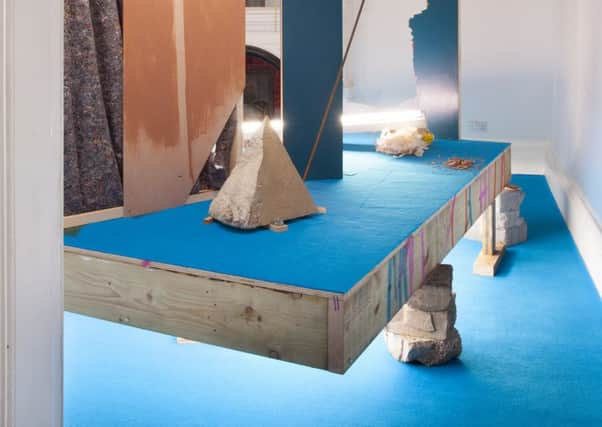Arts review: Twin Fields, Common Guild Glasgow


Ann Hardy – Twin Fields
Common Guild, Glasgow
Star rating: ****
I can’t recall it being as utterly transformed, or as deeply unfamiliar, as it now appears in the capable hands of London artist Ann Hardy.
Throughout the building the wooden floors have been muffled in a carpet of a harsh cyan blue, with occasional elements of green and red. In the ground-floor gallery, the windows are shuttered and obscured. There are hanging blankets that dampen the acoustic and the glorious natural light has been replaced with the cold, white hum of crudely suspended fluorescents. It is quickly apparent that the gallery is not the passive, polite host of the artwork but that its very architecture has been co-opted to become the work itself.
Advertisement
Hide AdHardy, who will open a solo exhibition at Modern Art Oxford in November, has recently moved out of the realm of pure photography and into full-scale sculptural installations. Once she might have spent months creating a work in her studio only to photograph and subsequently dismantle it. Her images had a carefully crafted desolation to them, often implying a place or moment that was past its best. Yet the notion of picture making seems still to be central.
At the Common Guild you sense the possibility that at any minute the objects around you might shift from three dimensions into two. The architecture transforms radically as you shift viewpoint or perspective. Crude apertures appear, chinks of light, as a result the gallery rooms and the work itself seem to flatten or bulge unexpectedly.
Twin Fields has a deep melancholy, although no clear narrative thread. Hardy’s materials are humble. There is breeze bloc, perilously stacked high or crowded and crumbled on the floor. There are half deflated balloons, plasterboard and timber, insulation material and rebar, that simple metal rod that provides the hidden structural strength of concrete
These are largely construction materials and they seem to get to the nub of something key to Hardy’s work. They are the kind of materials that you tend to find hidden in the fabric of buildings rather than somewhat cruelly exposed. They demonstrate the difference between outside and inside, between appearance and true volume, between the stuff that is displayed and the stuff discarded or disguised. This becomes more apparent as you move upstairs, where a crude shed-like structure unexpectedly opens into a tight interior world with audio of sawing and grinding that might be the soundtrack of making of the show.
In making the shift from sculptural picture-making to a kind of pictorial sculpture, Hardy’s work loses nothing of its enigmatic charisma but gains in substance. Despite the suppression of its finest features, the same might be said for the beautiful gallery building itself.
Until 16 August